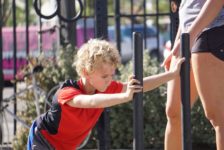
We’ve all wondered it: “Is it true if you don’t use it, you lose it?” Well, while it might not be true in sex education, it is true with human movement. Last week we talked about agility and it’s general misperception. Well, movement brings the mental firing patterns required to tell your body what to do to the forefront of your mind. The more movement you do, the more “fresh in your mind” the patterns become. This makes us more agile in our ability to move between patterns from say walking to sitting to back peddling.
Our dear friend and world record holding coach, Shane Sweatt, reminded us that in elderly men and women the avoidance of stairs, for example, diminishes their ability to recall the movement patterns to do something as simple as step down to a lower step. They’ve lost the agility required to transition from walking on a flat floor to changing the plane of their gait. This is why elderly folks suffering from this may get stuck holding the hand rail with their foot dangling unable to step down.
This shows up in the gym quite often, actually, when adults don’t remember how to jump up onto something. Instead they stand in front of a modest sized box, frozen, and unable to pull the trigger.
Research is showing the earlier and more completely babies understand how to move, in cross crawl patterns especially, the more agile they will be to express coordination, agility, and new learning later in life. That’s right us coaches can often tell when you didn’t crawl enough as a baby. (SEE: Dance floor embarrassment)
Regardless of which stage you are in, albeit infancy, childhood, adolescence, adulthood, or your senior years, movement is vital. In fact, what we’re finding is that not only is movement vital, the preservation and variety of movement is key for reasons that pale in comparison to gym goals much later in life.
Logan Gelbrich
@functioncoach
10/4/16 WOD
EMOM 10
Odd: 100’ DB Overhead Carry (70/50)
Even: 7 Toes to Bar
Then, complete the following for time:
21-15-9
Deadlifts (225/185)
Box Jumps (30/24)

